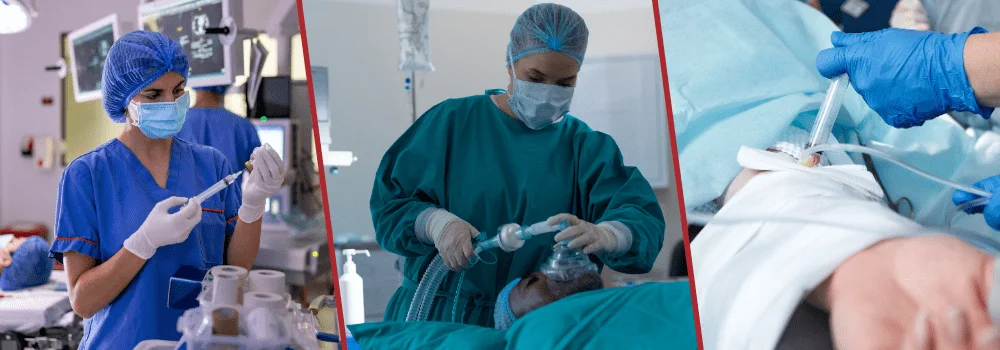How to Become an Anesthesiologist?
Your Comprehensive Guide to Becoming an Anesthesiologist

In this Career Outline

Introduction to Anesthesiologist
"Become an anesthesiologist and master the art of safely navigating the realm between life and painlessness."
Imagine stepping into a world where your decisions directly impact the comfort and safety of patients undergoing surgery. As an anesthesiologist, you hold the key to administering anesthesia, monitoring vital signs, and ensuring pain management postoperative. This role blends medical expertise with precision and compassion, making it indispensable in the healthcare landscape. If you're intrigued by the prospect of mastering anesthesia techniques and collaborating closely with surgical teams, then becoming an anesthesiologist might be your calling. Let's delve into the journey of how to become an anesthesiologist, exploring the educational path, necessary skills, and promising career opportunities ahead.
Steps to Become an Anesthesiologist:
Step-1
Obtain a bachelor’s degree from an accredited college or university. While specific majors aren't always required, coursework in biology, chemistry, physics, and mathematics is beneficial.
Step-2
Prepare for and take the MCAT exam, which is required for admission to medical school in the United States and Canada.
Step-3
Complete four years of medical school to obtain a Doctor of Medicine (MD) or Doctor of Osteopathic Medicine (DO) degree. Focus on courses related to human anatomy, pharmacology, physiology, and medical ethics.
Step-4
After medical school, participate in a four-year residency program specializing in anesthesiology. This residency provides hands-on training in surgical anesthesia, pain management, critical care medicine, and perioperative medicine.
Step-5
Obtain a medical license by passing the United States Medical Licensing Examination (USMLE) or the Comprehensive Osteopathic Medical Licensing Examination (COMLEX-USA), depending on whether you have an MD or DO degree.
Step-6
Consider completing a fellowship program to further specialize in areas such as pediatric anesthesia, cardiac anesthesia, pain medicine, or critical care medicine. Fellowships usually span one to two years.
Step-7
Stay current with advances in the field and meet continuing education requirements to maintain board certification through the American Board of Anesthesiology (ABA) or the American Osteopathic Board of Anesthesiology (AOBA).
Eligibility Criteria
| Eligibility Criteria | Description |
|---|---|
| Eligibility | At least 50% aggregate in 10+2 examinations |
| Educational Background | Completion of high school with a strong foundation in science subjects such as Biology, Chemistry, and Physics. |
| Undergraduate Degree | Obtain a Bachelor's degree in Medicine (MBBS) or an equivalent undergraduate medical degree recognized by the Medical Council of India (MCI) . |
| Postgraduate Degree | Complete a Doctor of Medicine (MD) in Anesthesiology or a Diploma in Anesthesia (DA) postgraduate program. |
| Entrance Exams | Qualify in entrance exams such as NEET (National Eligibility cum Entrance Test) for MBBS in India and NEET-PG for MD courses. |
- To pursue a career as an anesthesiologist, you must first complete high school with a strong background in science subjects such as Biology, Chemistry, and Physics.
- After high school, aspiring anesthesiologists need to obtain a Bachelor's degree in Medicine (MBBS) or an equivalent undergraduate medical degree recognized by the Medical Council of India (MCI) or relevant medical authorities.
- Following the completion of the undergraduate degree, individuals interested in specializing in anesthesiology should pursue a Doctor of Medicine (MD) in Anesthesiology or a Diploma in Anesthesia (DA) postgraduate program, typically lasting 2-3 years.
- Entry into both undergraduate and postgraduate medical programs in India requires qualifying in national-level Entrance exams after 12th such as NEET (National Eligibility cum Entrance Test) for MBBS and NEET-PG for MD courses, essential steps towards securing admission and progressing in the field of anesthesiology.

Not eligible to pursue this career?
Find out different career options based on your current academic accomplishments. Enquire with our career experts and build a roadmap to your career success!
Tasks to perform as an Anesthesiologist:
Knowledge & Skills Required
Anesthesiologists need a diverse skill set to thrive in their roles. Here are the crucial areas of knowledge and key skills required for success in this field:
| Knowledge Required | |
|---|---|
| A deep understanding of human anatomy, physiology, pharmacology, and pathophysiology is crucial. | Mastery of various anesthesia techniques such as general anesthesia, regional anesthesia, and sedation. |
| Ability to assess patients preoperatively to determine their suitability for anesthesia and surgery. | Knowledge of acute and chronic pain management techniques, including post-operative pain relief strategies. |
| Collaboration with surgeons, nurses, and other healthcare professionals to ensure coordinated patient care. | Commitment to continuous professional development, staying updated with advances in anesthesia techniques, pharmacology, and patient safety protocols. |
| Skills Required | |
|---|---|
| Medical Knowledge | Pain Management |
| Anesthesia Techniques | Interdisciplinary Collaboration |
| Monitoring Skills | Communication Skills |
| Emergency Management | Continuous Learning |

The Knowlegde and Skills don't intrigue you?
Your career may not align with your interests. Identify them and match with careers requiring those skills for faster growth and success!
Job roles offered for an Anesthesiologist:
Once you've obtained the necessary qualifications to become an Anesthesiologist, numerous career paths become available. You can pursue various roles within this field or explore opportunities in other related fields.
Performs intricate laboratory tests on patient samples in accordance with rigorous clinical protocols. They analyze fluids and tissues to aid in disease diagnosis, treatment, and prevention. Medical technologists work in laboratories and require strong attention to detail and communication skills.
Supports anesthesia teams by preparing and maintaining anesthesia equipment, assisting during procedures, and ensuring equipment sterility and functionality. They work in various healthcare settings and must be adept at multitasking and understanding medical equipment.
Performs basic healthcare tests and procedures under supervision in laboratory settings. They collect, prepare, and analyze specimens, ensuring compliance with safety protocols. Medical technicians typically hold an associate's degree and require certification in healthcare technology.
Specializes in eye care, diagnosing vision problems, prescribing corrective lenses, and providing treatment for various eye conditions. Optometrists rely on optometric assistants to manage administrative tasks, prepare patients for exams, and maintain diagnostic equipment.

Not sure where you fit in?
With countless career options, choosing the right path can be tough. Analysis and guidance sessions help clarify what to study, pursue, and achieve.
Career opportunities in Anesthesiologist:
Anesthesiologists can opt for various fields of work in the companies listed below:
| Capitol hospital | East coast hospitals ltd. | Apollo Hospitals |
| Columbia Asia Hospitals Pvt. Ltd. | Midland Healthcare & Research Center | Virtua Health |
| Covenant Health | Medical College, Hospital & Research Center | Smiths Medical |
| K.D Medical College Hospital and Research Center |
Career opportunities for an Anesthesiologist:
Here is the list of colleges offering the Best courses after 12th:
| St Johns Medical College, Bangalore | KPC Medical College and Hospital, Jadavpur |
| IIMSR Lucknow - Integral Institute of Medical Sciences and Research | VIMS Bangalore - Vydehi Institute of Medical Sciences and Research Center |
| Shree Guru Gobind Singh Tricentenary University, Gurgaon | BJMC Ahmedabad - B J Medical College |
| NMCH Sasaram - Narayan Medical College and Hospital | Smt NHL Municipal Medical College, Ahmedabad |
| School of Medical Sciences and Research, Greater Noida | Dr BR Ambedkar Medical College, Bangalore |
End Note
Begin your rewarding journey to become an anesthesiologist with SetMyCareer’s expert Career counselling and guidance. Whether you're in India or elsewhere, it's crucial to understand the educational path, required skills, and career prospects. Connect with our experts today to chart your future in this vital healthcare role!
In this Career Outline
You don't fit in as an Anesthesiologist?
Find out your best suitable career by booking an appointment with our experts
Book nowGet In Touch
No. 14/595, 1st Floor, Nanjappa Reddy Layout, Koramangala 8th Block, Bangalore 560095





